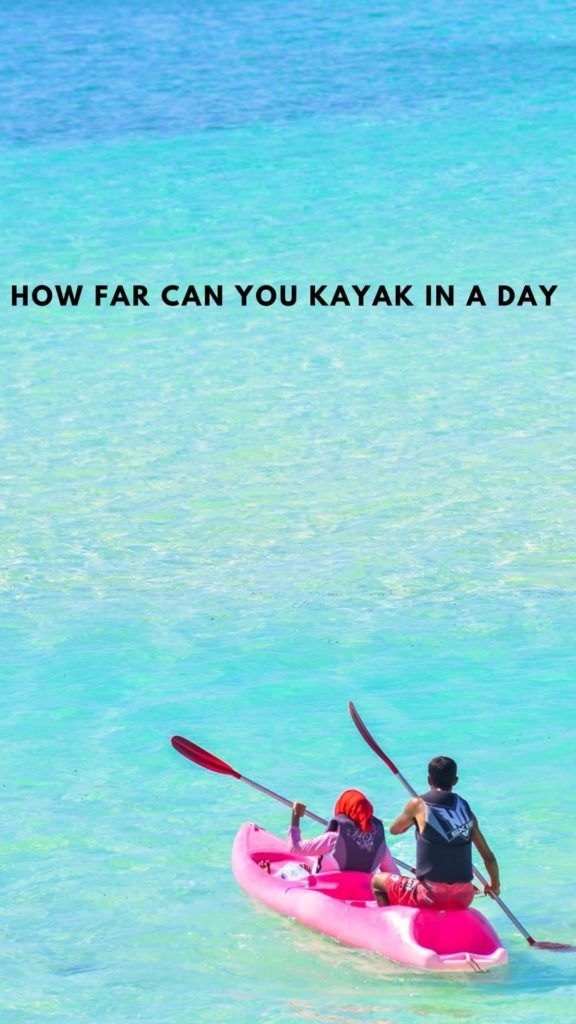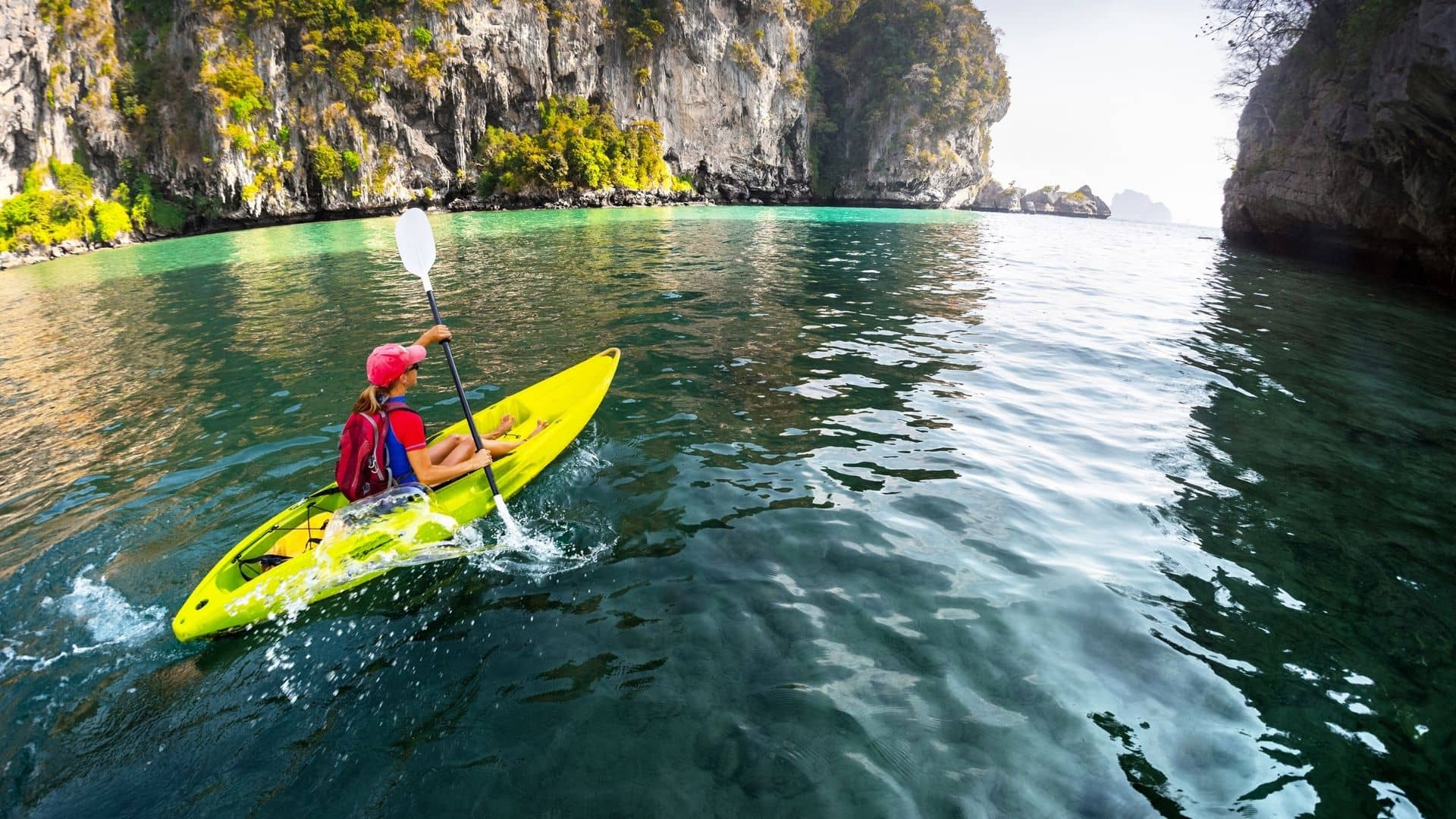In this article, I’ll share how far can you kayak in a day? You like to go kayaking. You must know some things. In this article, I discuss that technique. Generally, people kayak a particular area for some time.
But some people like to kayak for a lingering time and different areas than this article for you. For a long-time kayak adventure, you must figure out things like the weather, boat length. Also, average speed, health condition, and the time you like to spend over the water.
Do all these things help work out how far you can paddle a kayak in a day? A typical size solo kayak boat can reach 15 to 20 miles a day.
How Far Can You Paddle a Kayak in a Single Day

My first opinion toward “How Far Can You Paddle a Kayak in a Single Day” this question is-It depends on colorful situations.
In the field of regular paddling, if you’re planning on a trip, I don’t recommend planning to paddle to your limit. Assume you won’t have constantly favorable conditions. Then, leave yourself redundant time and energy to deal with extremities. Indeed, it’ll help you to paddle some redundant country miles.
It happens because of exercising effects like the low support stroke.
Still, this ratio can vary, depending on the sort of kayak that you’re using. Longer sitting inside kayaks can be much further hydrodynamic. Either, it helps to achieve advanced pets.
There are so numerous options to take into attention when figuring out how far you can pole in a day.
Physical Abilities
It depends on other factors and may veritably well take a first-year student 1-2 country miles in the water.
Weather Conditions
During stormy days the same maybe. Getting wet can decelerate you down. Especially if you are not ready for the rainfall, wear applicable apparel to stay dry while pulling.
Water Conditions
You can be suitable to kayak for redundant time. However, An educated paddler and have the correct toleration position.
For representative, in a standard plastic kayak of 5 measures long. A 50 cm wide ray without notable weight can be sculled by a relatively taught rower with moderate strength for a 4 kilometers per hour speed.
Endured scullers say that the longer the kayak, the brisker can be sculled. Where featherlight kayaks aren’t as effective in grueling rainfall conditions.
How Does Your Kayak Affect How Far Can You Row?
If you want to use a short paddle or too long paddle, then you simply exhausting yourself. While It takes more effort to keep the kayak on track. Yet, your hands will direct to pass along the handle, working in the development of flaws.
The suitable kayak itself, your paddle, has the most significant impact. Especially on your performance on the water. Indeed a short stint involves thousands of strokes. So that a proper paddle can make all the difference. Your paddle’s blade size and shape affect its effectiveness in the water.
Because of that, a carbon paddle is undoubtedly a good property. Its light motion weight will ensure hours of paddling. Without much pressure, as well as times of continuity.
Suppose this question arises on the kayaking distance calculator. The simple answer will be 1.25 hours of total float time for a 3-mile trip.
Key Factors that Affects Kayak Paddling Speed
Numerous paddlers aren’t concerned about how far you can kayak in a day. Their pretensions are different – Whether it’s simply having fun on the lake or having adequate space to put their fishing gear. Continue reading if you’re intrigued about what factors influence average kayak speed. Then there are the four major kayak rate determinants.
The average kayak speed is based on the length of your kayak. If you watch any Olympic paddle-sport event, you’ll notice that the kayaks are much prolonged than the ones you’re used to. There’s a reason behind this: kayak length is the most efficient way to travel quickly on the water. Then a scientific explanation why At pets approaching‘ housing speed,’ surge drag dominates.
- Housing speed is the theoretical maximum speed of a given relegation housing. Proportional to the square root of the kayak’s waterline length. A longer kayak will have advanced‘ housing speed,’ reaching a progressive maximum speed rate. It’s vital to realize that reaching full speed takes a lot of effort from the paddler. In other words, the shorter the kayak length is, the faster you can paddle.
- Kayak speed is determined by the range of your kayak. As kayaks get longer, they tend to get shorter in the field. Because the proportion of length to range grows, so does housing speed. While the range is lower than length, the content impacts the coming determinant of kayak speed.
- The effectiveness of the paddler determines kayak speed. There’s no getting around it When it comes to kayaks. You’re the machine that propels it ahead. So, the better a paddler you are, the faster you’ll go.
- Kayaks that are longer and narrower are less stable than those that are shorter and wider. Paddlers will be less effective in their longer kayak until they acclimate to this difference.
- A reversible response occurs when reactants are converted to products. When products are converted back to reactants at the same time. In this lab, it’ll be a dynamic equilibrium response. In chemistry, dynamic equilibrium means that in a reversible reaction. Also, the response rates of its reactants and products are equal. Since each chemical reacts at the same rate, it means there’s no real change. Thus, it’s a specific illustration of a system called the steady-state.
- Ultimately, your housing material determines kayak speed. As the price of kayaks geared for speed rises, you’ll note that the housing material changes. Ranging from a range of plastics to fiberglass and, eventually, carbon blends. These accouterments are decreasingly lighter and also have lower water resistance. These variations may be insignificant to the ordinary paddler. But for those who need speed, housing composition. That can provide the final edge needed to reach the tribune.
Tips to Go Far By Kayaking
Paddling a kayak is hard to do gracefully. When you think about it, you’re probably worried about deliberately hurting yourself into the drink. Sitting in a chair in a water style, flourishing your arms with little influence.
Paddling, on the other hand, can be a gorgeous, flowing ballet on the water. And it’s a thrill to see a really professional paddler dance in their boat. Whether your playground is whitewater gutters, the ocean, or calm lakes, then are some tricks to become more fluid while on the water. In this case you can use a tandem family kayak.
Farewell to Arms
Paddling appears to be an upper-body sport at first appearance. But that is the biggest deception about paddling. Your arms should only be used to hold the pedals and keep them in place.
Detach your upper and lower body
There is extreme boat control under the sprayskirt with a subtle variation of your weight. Graceful paddlers can turn the kayak, go straight, or accelerate anything without taking anything apart. The ability to move the lower body in a completely different direction. From your body is the most critical aspect of building a kayak cotillion. In the process, you’ll discover a bunch of tiny muscles in your hips and lower abs that you didn’t realize you had.
Remain on the edge
Shore your boat with your hips and knees. Suppose both are different. This is how to bend statues, ferry currents, or offset windy goods. Large beamed kayaks are harder to shore, so they feel more secure when new to people. They also do not perform well in current or dynamic water.
Use your trim
The movement of the astral body is not only towards the kayak. If you want to achieve navigation, Back and forth with your weight changes. Subtle changes ahead will make a kayak turn on or upwind and lean back slightly unless you are away from the power position for long periods. The effect will create a heads-up current or downwind.
Back it up
Pedal back. Turn backward. Go straight, go back. Use different edges and trims going backward. There will be two effects. A good option would be the core to use the legs to gain power. It demonstrates that you will eventually stop using your arms. Second, you’ll learn about the origins and consequences of strokes and edges. You might have got some confusion at first, but you will have a blast. You will have a shot. You will have a blast once you figure it out.
Goof around
Play! Run around buoys or needles, take the slalom course among your gunners. Moreover, retake tennis, build the game, have water fights. You’ll stop agonizing over what you’re doing and do it. Then you’ll learn to be stylish. You’ll also have a grin on your face.
Relax
Be at ease. Don’t worry about bending over and having fun on the water. When you rest, your body loosens up – making it less likely to happen. Look around, watch short. You will have a blast, have a shot at you, blast the wildlife, prank your gunslingers, and enjoy being on the water. It comes from being graceful paddling.
Ending Thoughts
I think this content will assist you in helping more kayak paddling to move far beyond your journey. All issues discussed are for your better understanding. You know, Paddling is perfect for health where kayak adds some extra value. Keep practicing, be healthy and happy.

